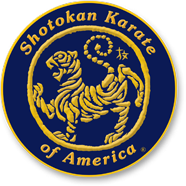Portions of the following have been excerpted from Karate-do Kyohan by Gichin Funakoshi:
Kata (forms) are set combinations of moving blocks, punches, kicks, joint techniques, and throwing which have been passed down from senior to junior for generations.
In SKA, instruction is usually given in the following nineteen kata: Taikyoku Shodan, Nidan, and Sandan as forms for beginners; Heian Shodan, Nidan, Sandan, Yodan, and Godan, Bassai, Kwanku, Empi, Gankaku, all of the Shorin school (Northern Chinese ‘soft’ school); Tekki Shodan, Nidan, and Sandan, Jutte, Hangetsu, and Jion all of the Shorei school (Southern Chinese ‘hard’ school); and Ten no Kata as a kumite form. Master Funakoshi changed the names of some of these kata when he taught karate in Japan to make them more meaningful to the Japanese. In the past, the Heian kata were called ‘Pinan’ kata, the Tekki kata were called ‘Naifanchi, etc. Some of these forms have been practiced for 500 years or longer. Ten no Kata was developed during the last century.
Until one has learned the order of the kata, he should concentrate on this rather than on applying much strength. After understanding the basic structure of the kata, one should then gradually apply more strength. Finally, once he has completely learned the order and acquired a feeling for the kata, he should then begin study of the next kata. Do not expect good results in a short time. Karate training may extend over one’s entire life, beginning ideally in junior high school years. Heavy training before the body is properly conditioned can result in injury to the body, so train systematically, without becoming impatient or overexerting yourself, and develop gradually, one step at a time, with increased application of force and numbers of exercises practiced.
Three important dynamics should be kept in mind during karate practice:
- light and heavy application of strength
- expansion and contraction of the body
- fast and slow movements in techniques
Practice each kata many times. 500 repetitions of a kata is a start. 5,000 repetitions is usually sufficient to begin to understand a kata. Many more repetitions are required to deeply understand a kata. Try to perform kata smoothly and precisely, without unnecessary tension in the body, in a very alert and focused frame of mind, in exact stance and posture, with attention to dynamics of speed, application of power, expansion and contraction , mindful of the meaning or practical application of the kata.
